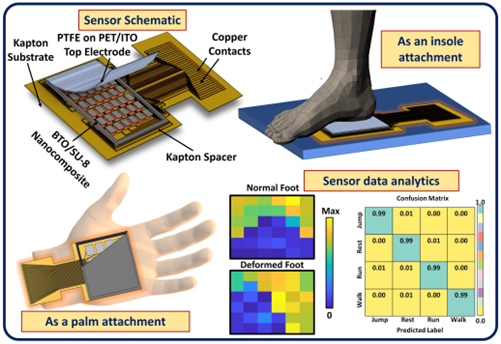- Sensor can potentially provide an easy, low-cost alternative to expensive footwear modifications, surgeries, and posture correction accessories
Gait (how we walk) and postural (how we carry ourselves while sitting or standing) deformities are common in the present world.
The most prominent deformities include splay foot, flat foot, unstable hind foot with protruding heels, high arches, and irregular gait. They are directly associated with poor balance, abnormal posture, swollen knees, and joint weaknesses that cause difficulty in walking.
Researchers have been working extensively on postural deformity detection and their efficient corrections.
Researchers at IIT Delhi have developed a scalable, wearable pressure sensor based on a nanocomposite material.
The product has:
Light-sensitive polymer
Piezoelectric nanoparticles,
Both of these offer an easy array design for pixelated (that which can be seen over a graph and pinpointed accurately) sensing over large area, simple process flow, and low-cost implementation.
A research study titled ‘Machine Learning Assisted Hybrid Transduction Nanocomposite Based Flexible Pressure Sensor Matrix for Human Gait Analysis’ by research scholars Nadeem Tariq Beigh and Faizan Tariq Beigh, and Prof. Dhiman Mallick, all from the Department of Electrical Engineering at IIT Delhi, has published in Nano Energy (research paper link https://doi.org/10.1016/j.nanoen.2023.108824), which is a leading journal in the field of nanotechnology with impact factor of 17.6. This work is financially supported by I-Hub Foundation for Cobotics, Technology Innovation Hub of IIT Delhi.
The study found that the sensor can comfortably fit inside the insole of varying sizes. It can also be easily attached at the palm or any body part where localized pressure sensing can be useful.
The sensor can identify mechanical strain as well as contact force/pressure at the same time.
The sensor generated output is analyzed by conventional Machine Learning models and linked to a person’s walking behaviour. By comparing the pressure patterns to those of pre-defined patterns of a normal person, clinical specialists can conclude the type of deformity present.
The resulting pressure patterns can aid doctors and specialists in designing custom insole that balance out the foot deformity by supporting regions of the foot showing abnormal pressure distribution. In effect, the proposed sensor can potentially provide an easy, low-cost alternative to expensive footwear modifications, surgeries, and posture correction accessories.
Additionally, the sensor can help in understanding different human activities. For instance, it can figure out if the user is walking, running, or doing something else by feeling the pressure changes in user’s hind foot. The sensor considers the variability of foot pressure during various biomechanical movements, which helps it to correlate each pressure pattern to a given activity.
This has tremendous application in smart healthcare systems wherein the activity pattern, exercise intensity, number of steps, etc., form important parameters for critical health analysis in people with diabetes, obesity, etc. Additionally, the sensor can be helpful for elderly fall detection, especially in patients with Parkinson’s disorder or who are disabled.
It can also be used for injury rehabilitation. For instance, the sensor has been utilized to assess hand grip strength. In situations with injuries to the limbs or palms, the strength of the grip is directly related to the healing progress.
The device is at research stage. Commercial utilisation is yet to be explored.

